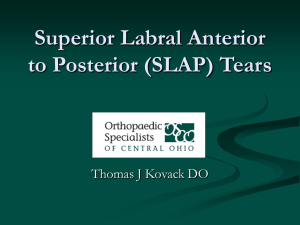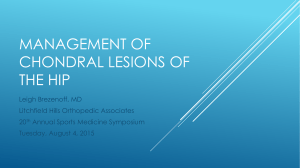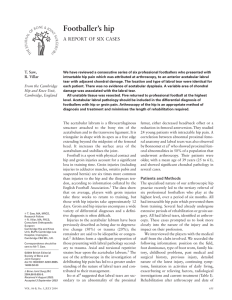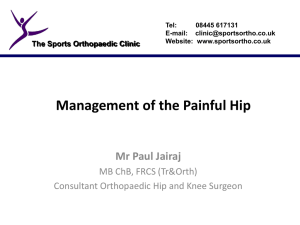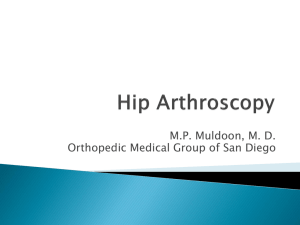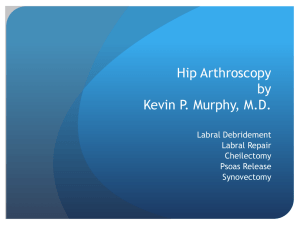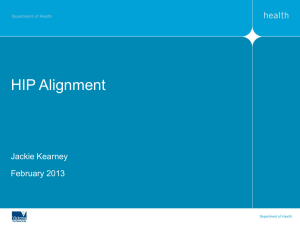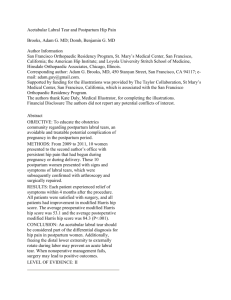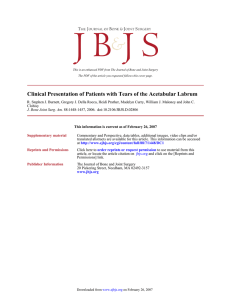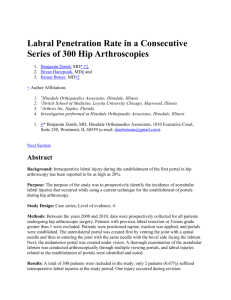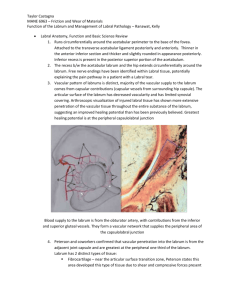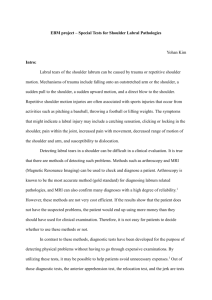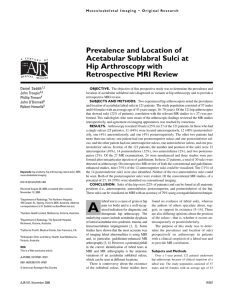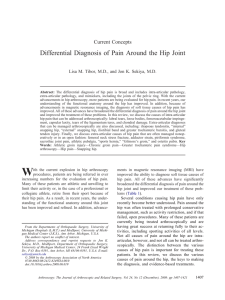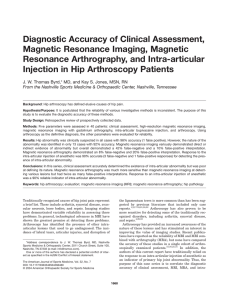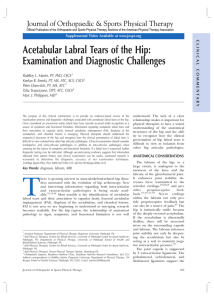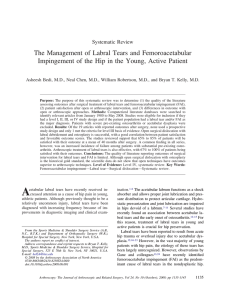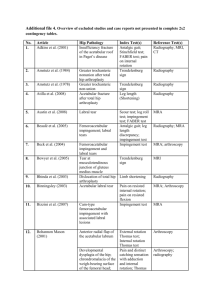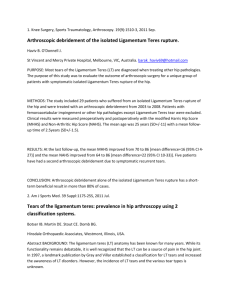Application of Hip Arthroscopy
advertisement
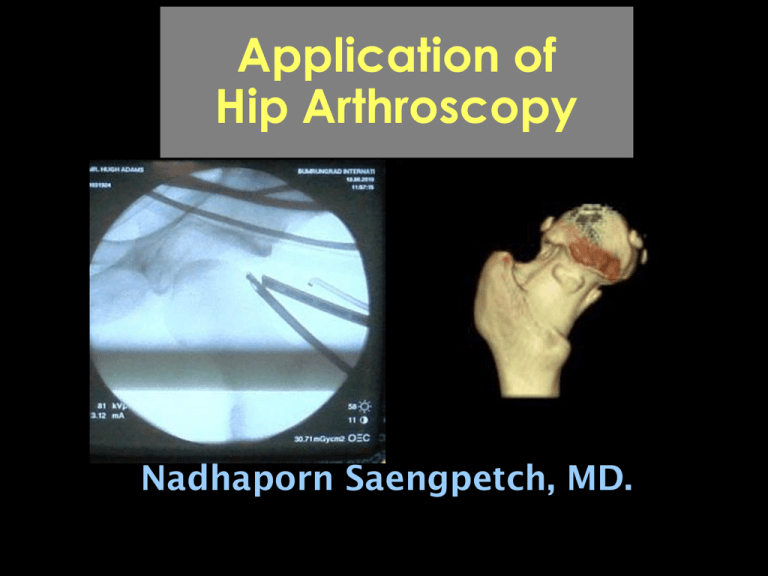
Application of Hip Arthroscopy Nadhaporn Saengpetch, MD. Objectives • To understand the spectrum of disease that is compatibly treated with hip arthroscopy • Have a basic understanding of the relevant anatomy , history and examination for hip pain • To introduce the surgical technique and its limitation Once upon a time…. • 1802 Dr. Phillipp Bozzini “Lichtleiter” • 1931 Dr. Micheal S. Burman 20 cadaveric hip joints First Clinical Application : 1939 Dr. Kenji Takagi 2 Charcot joints 1 Tbc arthritis 1 Supparative arthritis J Jpn Orthop Assoc 1939 Anatomy Hip Arthrogram Tip of Physical Exams • Differential diagnosis to intra/extraarticular pain, pubic pain • One joint above and below • Gait : LLD, pelvic obliquity • foot-progression angle & muscle contraction Impingement Sign Tip of Physical Exams • Intra-articular lesion : log rolling, McCarthy hip extension sign • SI problem : FABER test • Hip flexion contracture : Thomas test • Piriformis syndrome : sit & active ER • Hip dysplasia : anterior apprehension test ( extend & ER) FABER Test Differential Diagnosis of Groin Pain 4 zones of groin pain Differential Diagnosis of Groin Pain Osteitis Pubis : Soccer Player F 20 yo. w/ hx of posterior dislocation for 4 y. PTA CT scan 3D-CT scan Disorders That May Benefit from Hip Arthroscopy Labral Tears Labral Tears • Traumatic tears posterior hip dislocation pain/catching after twisting or slipping repetitive hyperflexion Labral Tears N. America : 436 hips, 96% were anterior lesion (twist, pivot) McCarthy JC. JBJS Am May 2005 Asian hips were most posterosuperior lesion (hyperflex, squat) Ikeda T. JBJS Br June 1988 MRI : Labral Tears Labral Tears • Degenerative tears OA hip relieve mechanical symptom in some pts did scope in early OA pts worsen outcome (Walton NP. Int Orthop June 2004) Arthroscopic Classification of Hip Labral Tears *Radial flap Longitudinal Radial fibrillated Complex Lage LA. Arthroscopy Dec 1996. Debridement of Labral Tears Arthroscopic Labral Repair Labral Tears • Hip dysplasia – selected patient – literatures devoid of studies this patient population, open acetabular osteotomy remains reasonable & welldescribed treatment – shollow acetabulum subluxate & distribute abnormal stress from a head on the labrum Chondral Lesions • Lateral impact mechanism ( by GT) • Associated labral tears 55.3% (McCarthy JC. Clin Orthop 2001) • Cartilage stimulation • ACI • Future : more predictable cartilageresurfacing procedure Chondral Flap Tear and Microfracture Labral Lesion with Chondral Lesion •Subchondral cyst formation •Synovial fluid burrows beneath the delaminating cartilage and subchondral bone Risk Factors of 2º OA from Labral Tears • With developmental dysplasia • Tears > 5 years old • Full-thickness chondral lesion Ligamentum Teres Ligamentum Teres Rupture • Deep anterior groin pain • Mechanical symptoms • History of significant trauma • Associated pathology : labrum, LB, chondral damage • ? Incidence (Byrd JWT. Arthroscopy April 2004) Ligamentum Teres Rupture Snapping Hip (Coxa Sultans Interna) Iliopsoas bursitis Iliopsoas Tendon Release Iliopsoas Tendon Release Pipkin Fracture Loose Bodies Removal Synovial Abnormalities • Chondromatosis • Crystalline disease • RA/SLE • Ehler-Danlos : capsular shrinkage Femoral Acetabular Impingement (FAI) • Leads to OA hip • anterior head-neck offset or acetabular overcoverage Radiographic Workup • AP view • Lateral view (Cross-table) • Lateral view (Dunn, false-profile) Alpha angle Control 42º FAI pt 74 º (Notzli HP. JBJS Br March 2002) MRI : coronal plain Cam Type • Caused by shear forces of the nonspherical position of the head against the acetabulum • Anterosuperior cartilage • Predisposing factors : SCFE, abnormal epiphyseal extension, malunion neck/head fracture, and femoral retroversion Cam Type Pincer Type • Repetitive stresses of a normal neck against an abnormal acetabular rim (over-coverage) • Antero-superior labrum “coup” • Postero-inferior head “contre-coup” • Predisposing factors : acetabular protrusio/retroversion, malunion acetabulum, 2˚ from osteotomy Pincer Type Normal Cross-over sign Mixed Type • Combine head/cup lesions • Less isolated type (Cam 9%, Pincer 5%) (Beck M. JBJS Br Jan 2005) Chilectomy (Osteochondroplasty) Arthroscopic Osteochondroplasty Arthroscopic Osteochondroplasty Osteonecrosis • Limited role only in a good spherical head to map a chondral lesion • Procedure before free fibular grafting/core decompression • Reserved for mechanical symptoms “is still debating…” Other Indications • Biopsy of lesions • Synovectomy / bursectomy • Diagnosis of pain • Septic arthritis • After THR What is this? PVNS Contraindication • Advanced arthritis • Stiff hip • Heterotopic ossification • Severe dysplasia “A surgeon is just a regular doctor, with few special skills.” Dr. B.F. Bryd, Jr. Equipments Set up Fracture table Fluoroscope Well-padded booties Perineal post Well trained flu technicians Booties Standard Portals Peroneal Post or Bean Bag? Hip arthroscopy without a perineal post : a safer technique for hip distraction • Decrease risk of pudendal nerve palsy • Deflated beanbag contoured around the flank and thorax (Merrell G. Arthroscopy Jan 2007 23(1):10)7) Traction Time • Not more than 1-2 hrs • The lesser time, the lower complication • HA without traction peripheral lesions younger age pts Approach Techniques Supine Lateral 3 Common Portals 1. Anterior portal 2. Lateral portals - Lateral-anterior portal - Lateral-posterior portal Portals * * * Landmark : anterior portal Vulnerable structures Adequate Distraction Distracted joint space 7-10 mm. Surgical Instruments Surgical Instruments Spinal needle Nitinol wire Cannulated obturator Glick Arthrex Set Extra-long scopes both 30º and 70º Common Steps 1. Peripheral area assessment 2. Do the labral or chonral procedures 3. Flex an affected hip 45º, release traction 4. Exam the L. teres lesion or osteochondroplasty (Chilectomy) 5. Move the leg : check adequacy of cartilage/bony removal Complications • 1.4-7% • sciatic and femoral neurapraxia* (resolve in 2-3 d) • Perineal injury • Portal bleeding • Trochanteric bursitis • Intra-articular instrument breakage Catastrophic Complications • O.5% permanent (Sampson TG. Clin Sports Med 2001) • Permanent sciatic and femoral nerve damage • Femoral vascular injury • *Septic arthritis • **Cardiac arrest : intra-abdominal extravasation of fluid (Acetabular fx) (Bartlett CS. J Orthop Trauma Dec 1998) Metallic Stain PRAY PRAY F F R JAPAN R RESIDENT RTHOPAEDIC RAMA
